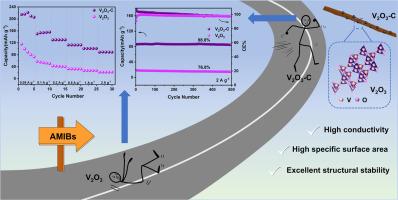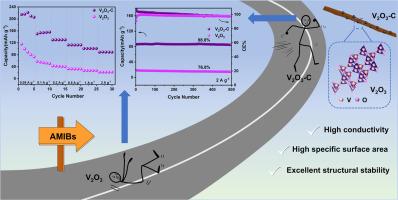In situ synthesis of a V2O3/biomass cotton-derived carbon composite for aqueous magnesium-ion batteries
IF 5.6
3区 材料科学
Q1 ELECTROCHEMISTRY
引用次数: 0
Abstract
Vanadium trioxide (V2O3) shows potential as a cathode material for aqueous magnesium-ion batteries due to its high theoretical specific capacity. However, its low specific surface area, low electrical conductivity, and poor cycling stability limit its practical application. In this work, the V2O3 was successfully grown on the surface of carbonized cotton fibers (V2O3-C) via a hydrothermal carbonization method. The introduction of cotton-derived carbon can enhance the conductivity of V2O3-C and serve as a supporting scaffold, providing anchoring sites for V2O3. Furthermore, the nanorod/nanofiber structure provides high porosity and large surface area, which increases the electrode-electrolyte interface and facilitating rapid ion transport. The abundant -OH in cotton fibers anchor V via coordinate bonds, preventing vanadium dissolution and dramatically improving cycling stability as an AMIBs cathode. Thus, the composite shows 215 mAh g-1 at 0.05 A g-1 and maintains a 98.8 % retention rate after 500 cycles at 2 A g-1. Notably, ex situ analysis confirms the charge storage mechanism is primarily Mg2+ intercalation/deintercalation. Furthermore, The V2O3-C//PTCDA full battery exhibits exceptional cycling performance with the 89.5 % capacity retention after 1400 cycles at 0.5 A g-1. This study demonstrates the promise of combining biomass-derived materials with V2O3-C for high-efficiency AMIBs.


用于水镁离子电池的V2O3/生物质棉源碳复合材料的原位合成
三氧化钒(V2O3)由于其较高的理论比容量,显示出作为水镁离子电池正极材料的潜力。但其比表面积小,电导率低,循环稳定性差,限制了其实际应用。本文采用水热碳化的方法,成功地在碳化棉纤维(V2O3- c)表面生长出了V2O3。棉源碳的引入可以增强V2O3- c的导电性,起到支撑支架的作用,为V2O3提供锚定位点。此外,纳米棒/纳米纤维结构提供了高孔隙率和大表面积,增加了电极-电解质界面,促进了离子的快速传输。棉纤维中丰富的-OH通过配位键固定V,防止钒的溶解,显著提高了作为AMIB阴极的循环稳定性。因此,复合材料在0.05 A g-1下显示215 mAh g-1,在2 A g-1下循环500次后保持98.8%的保留率。值得注意的是,非原位分析证实了电荷存储机制主要是Mg2+的嵌入/脱嵌。此外,V2O3-C//PTCDA全电池表现出优异的循环性能,在0.5 A g-1下循环1400次后,容量保持率为89.5%。这项研究表明,将生物质衍生材料与V2O3-C结合在一起,可以制造出高效的amib。
本文章由计算机程序翻译,如有差异,请以英文原文为准。
求助全文
约1分钟内获得全文
求助全文
来源期刊

Electrochimica Acta
工程技术-电化学
CiteScore
11.30
自引率
6.10%
发文量
1634
审稿时长
41 days
期刊介绍:
Electrochimica Acta is an international journal. It is intended for the publication of both original work and reviews in the field of electrochemistry. Electrochemistry should be interpreted to mean any of the research fields covered by the Divisions of the International Society of Electrochemistry listed below, as well as emerging scientific domains covered by ISE New Topics Committee.
 求助内容:
求助内容: 应助结果提醒方式:
应助结果提醒方式:


